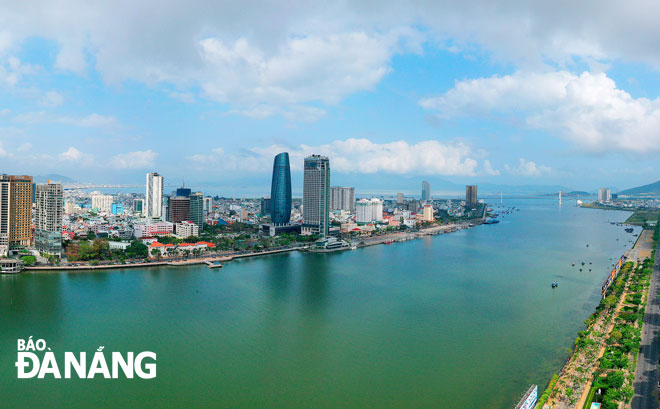Da Nang on course to become eco-city by 2030
Da Nang government has issued plans to implement the project ‘Building Da Nang into an Environmentally-friendly City’ for the 2021 – 2030 period at a total cost of VND15,546 billion. The project aims to realise Da Nang’s target of becoming an eco-city by 2030, and creating a safe and healthy environment for local residents, tourists and investors from both home and abroad. DA NANG Newspaper newspaper had an interview with Director of the Department of Natural Resources and the Environment To Van Hung on issues related to this project.
 |
| The implementation of the ‘Building Da Nang into an environmentally-friendly city’ project for the 2021 – 2030 period aims to realise the target of becoming an eco-city by 2030. Here is a view of urban areas developing harmoniously along both sides of the Han River |
The landmark project ‘Building Da Nang into an environmentally-friendly city’ started in 2008, a bold and creative decision demonstrating the city's determination to protect the environment.
On its ambitious journey to develop itself into an environmentally-friendly city, Da Nang yielded some encouraging results.
Noticeably, in 2012, Da Nang was one of the 20 Asia-Pacific Economic Co-operation (APEC) cities chosen to carry out a Low-Carbon Model Town Project involving smart grids and renewable power generation. Also, the city was given the title of National Green City 2017 - 2018 by the World Wide Fund for Nature (WWF)’s One Planet City Challenge programme, making it onto a list of 21 cities from around the world.
In its efforts to keep this highly practical progress well in the time ahead, Da Nang government has given the green light to the spending of VND15,546 billion for the 2021 – 2030 implementation of the project.
Of this, VND5,436 billion will be funded by the State budget, whilst VND3,200 billion from ODA capital, and VND6,910 billion VND from organisations and individuals in society.
 |
| Director of the Department of Natural Resources and the Environment To Van Hung |
Under the plan, the project’s specific objectives are divided into key groups, namely environmental pollution prevention and control, environmental improvement, the solving of key environmental problems, the conservation of nature and biodiversity, capacity building and raising public awareness of environmental protection.
In detail, as for the environmental pollution prevention and control criteria, by 2030, there will be at least 3 eco-industrial parks and 25% of the public buses will run on electric motors. The rate of reduction of greenhouse gas emissions from electric and renewable energy development solutions by 2030 will decrease by 5 - 7%.
With regard to the criteria set for environmental improvement, by 2030, 100% of the urban population will be provided with clean water through a centralised water supply system. The rate of standardised treated urban domestic wastewater will hit 95%. More than 97% of collected and treated domestic solid waste will meet the prescribed standards. The rate of hazardous waste collected and treated in line with the regulations will reach 100%. Also, environmental pollution hotspots will be eliminated.
In the criteria for the conservation of nature and biodiversity, focus will be on ensuring no changes to land use purpose of natural and protection forests, promoting an increase in forest cover rate, maintaining the protected land area and protecting biodiversity, and ensuring that the allocation of public greenery land per capita in the inner-city areas will stand at 9m2 / person by 2025.
On the spotlight in capacity promotion and raising public awareness of environmental protection is to ensure that 100% of the local households carrying out waste sorting at the source will reach 100% by 2030, the rate of schools doing so will be 100% by 2025. 100% of feedbacks and recommendations on environmental pollution issues will be promptly resolved.
An eco-city is a human settlement modeled on the self sustaining resilient structure and function of natural ecosystems. The eco-city provides healthy abundance to its inhabitants without consuming more (renewable) resources than it produces, without producing more waste than it can assimilate, and without being toxic to itself or neighbouring ecosystems. Its inhabitants’ ecological impact reflect planetary supportive lifestyles; its social order reflects fundamental principles of fairness, justice and reasonable equity. Simply put, an eco-city is an ecologically healthy city.
To make its dream of becoming an eco-city by 2030 come true, Da Nang will attach importance to taking environmentally- friendly technical solutions such as developing smart transport systems, building urban parks, preserving nature reserve, improving the landscape and environment surrounding lakes and canals.
It isalso essential that the city build up a green economic model, waste audits, product lifecycle assessments and other advanced management models.
Besides macro and long-term strategic solutions, it is necessary for our community, with the active engagement by local residents and businesses, to take ‘green’ daily life actions. Activities supporting environmental protection movements, the regular ‘Green-Clean-Beauty Sunday’ campaign, for instance, will be kept progressive.
Also importantly, the circular economy, a modern economic model thought to be very suitable for Da Nang’s characteristics, must be given a lift to thrive further in the coming time. Promoting the circular economy for enterprises requires active innovation, investment in modern technology, limiting energy consumption, and using raw materials to produce output products capable of being recycled.
Reporting by HOANG HIEP – Translating by A.T